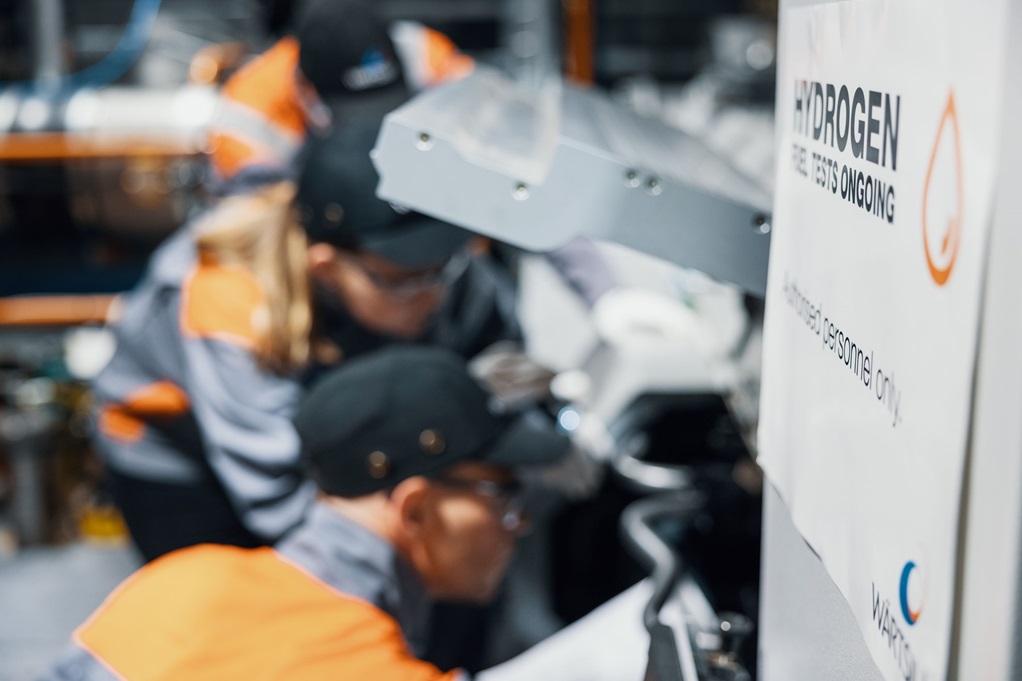Technology group Wärtsilä is part of a new research project exploring innovative technology for cleaner, more energy-efficient engines utilising a closed-loop combustion cycle. The research will focus on the use of argon—a non-toxic ideal gas present in the atmosphere—to increase the efficiency of balancing engines. The co-innovation project is run by the Integrated Hydrogen-Argon Power Cycle (iHAPC) consortium, led by the University of Vaasa, in partnership with Business Finland and a wide network of partners.
In an internal combustion engine, the energy supplied by combusting fuel is directly converted into mechanical power by the controlled combustion of the fuel in an enclosed space. In the Argon Power Cycle, air, which is normally used to combust the fuel in an internal combustion engine, is now replaced by argon and oxygen. The research focuses on scaling up the argon power cycle to medium-speed engines with full argon recovery. Argon enables a considerably higher thermodynamic efficiency due to its properties.
When using hydrogen, oxygen and argon as input, the only products from the process is water and the inert argon. Argon is recycled from exhaust to inlet, forming a closed-loop combustion cycle. Hydrogen and oxygen, the only inputs in the integrated Hydrogen-Argon Power Cycle, are both products of electrolysis, which increases the overall efficiency of the power-to-hydrogen-to-power process.
Rasmus Teir, Director of Sustainability & Future Plant Concepts at Wärtsilä Energy, says: “We have the technologies needed to deliver a 100% renewable energy future. And our ambition must be to continuously innovate solutions that further improve affordability and sustainability. The argon power cycle is an innovative technology that has the potential to impact these factors positively.”
Balancing engines are a vital component of the transition to renewable energy systems, providing essential power to balance intermittent wind and solar power and ensure grid stability. The most efficient engines run on gas today but are ready to be converted to sustainable fuels such as hydrogen when they are available at scale. With sustainable fuel production forecast to reach 38 million metric tons by 2030 (a third more than current demand), this transition is expected to be possible within the next decade.
The three-year project is part of the WISE (Wide and Intelligent Sustainable Energy) program, led by Wärtsilä and funded by Business Finland, the official government agency for trade, investment promotion and innovation funding. The partners of the iHAPC project are University of Vaasa, University of Oulu, VTT Technical Research Centre of Finland, Parker Hannifin Manufacturing Finland Oy, Vahterus Oy, Vaisala Oyj and TotalEnergies.
Professor Maciej Mikulski from the University of Vaasa, the responsible leader of the iHAPC project, says: “The argon power cycle enables full valorisation of green hydrogen with unparalleled power generation efficiency. I see this as a potential breakthrough for the energy sector. The University of Vaasa plays a crucial role in advancing such innovative energy solutions with a strong focus on sustainability. With our expertise in fuel analytics, modelling and simulation, powertrain testing, and control development, we are well-equipped and excited to lead this project.”
Tags: Argon, Hydrogen, Power, Wartsila



Recent Posts
Scandlines Nears Delivery of Zero Emissions Ferry Following Successful Sea Trials
India faces emission roadblocks with rising net-zero demands
Green Energy Resources invests in two electric Liebherr LHM 550
NYK Launches Continuous Use of Bio LNG Fuel on Car Carriers to Advance Decarbonization Goals
Yang Ming Expands Fleet with Methanol and LNG Dual-Fuel Vessels Under Fleet Optimization Plan
ClassNK Advocates Speed Gap Monitoring to Optimize Fuel Efficiency in Heavy Weather
Wärtsilä’s retrofit package for the Corsica Linea ferry Pascal Paoli has resulted in fuel savings of up to 22 percent Corsica Linea
COSCO Shipping Names Second Methanol Dual-Fuel Containership in Yangzhou